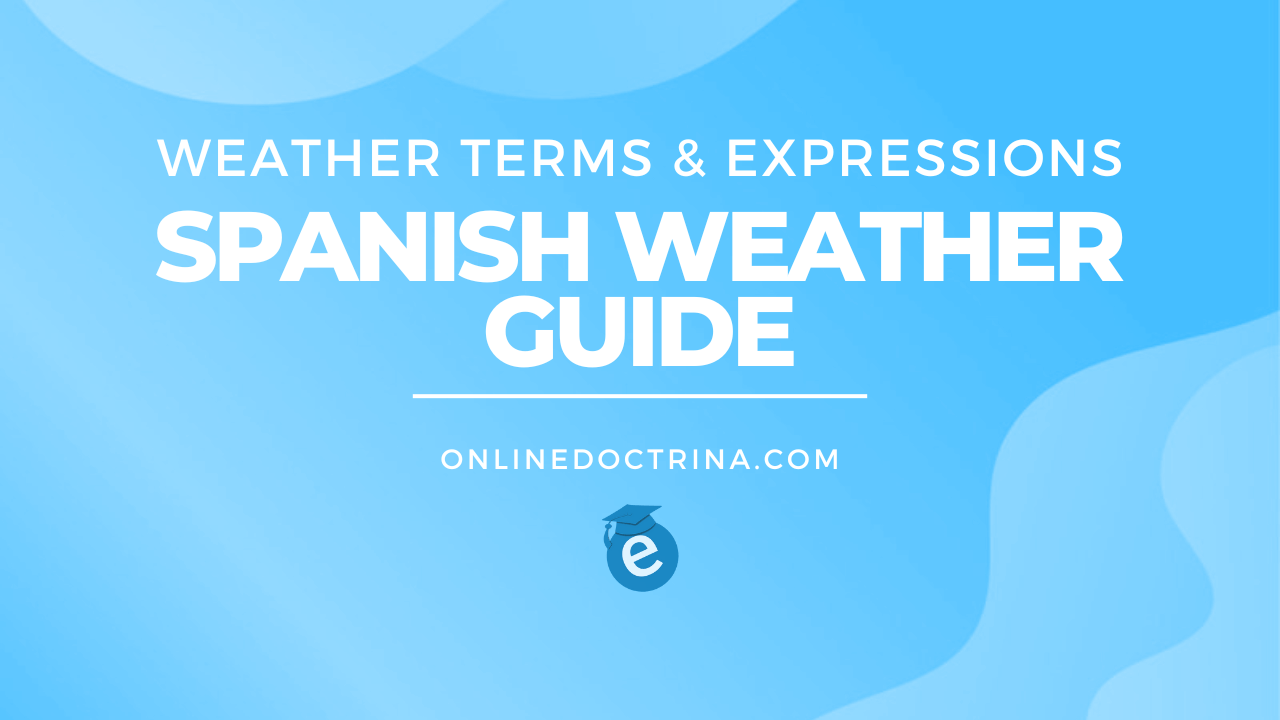No matter how hard I try, coming up with engaging conversation topics when meeting new people always seems to elude me. So, what’s my fail-safe strategy? Resorting to the timeless classic: discussing the weather! Whether or not you can relate, the ability to inquire about or discuss the weather in Spanish is a crucial skill for achieving fluency in the language.
Setting aside my somewhat lacking social skills for a moment, consider that weather is a universal topic woven into daily conversations. In this guide, we’ll delve into the following subjects:
Inquiring About Spanish Weather
Various questions serve the purpose of inquiring about the weather, each structured to extract specific information. The choice of these formulations depends on the particular details you seek. Here are examples, explanations, and formulas for utilizing these inquiries effectively.
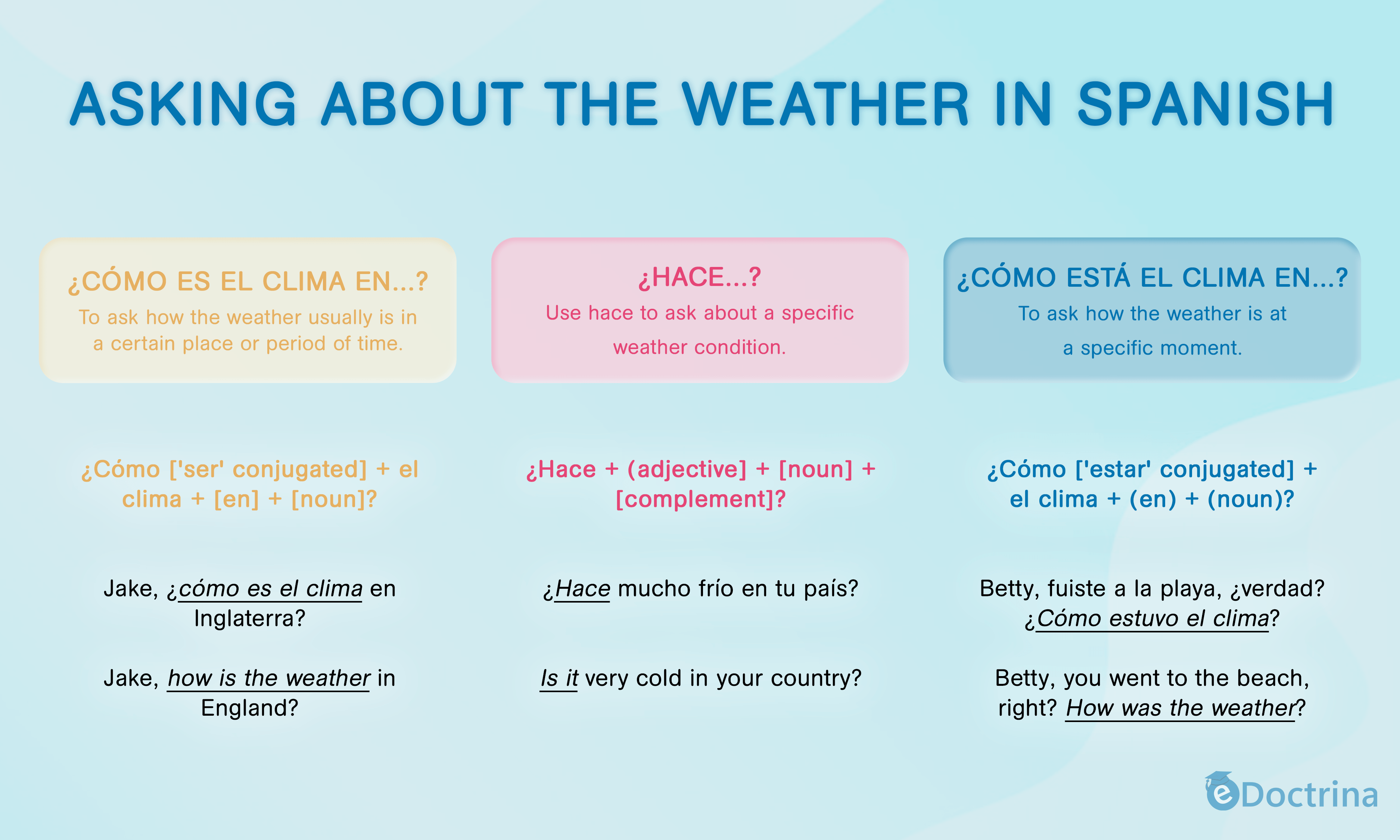
Do you want to learn more?
Join the e-Doctrina Spanish community and learn basic Spanish communication in a carefully graded way for beginners.
¿Cómo es el clima en…?
While this question is quite commonplace, it is typically employed when seeking a broad overview of the typical weather conditions in a specific location or timeframe. Explore these examples for clarity:
¿Cómo [ser conjugated] + el clima + [en] + [noun]?
Jake, ¿cómo es el clima en Inglaterra?
Jake, how is the weather in England?
Oigan, chicas, en Alemania, ¿cómo es el clima en verano?
Hey, girls, how is the weather in Germany during summer?
¿Hace…?
Employ “hace” to inquire about a specific weather condition. Despite its popularity, remember that this term is applicable only with specific words.
¿Hace + (adjective] + [noun] + [complement]?
¿Hace mucho frío en tu país?
Is it very cold in your country?
¿Crees que mañana hará calor otra vez?
Do you think tomorrow will be hot again?
Papá, cuando fuiste a Francia, ¿hacía frío o calor?
Dad, when you went to France, was it cold or warm?
¿Cómo está el clima en…?
Employ this Spanish weather expression whenever you wish to inquire about the current weather conditions. As an alternative, you can also utilize the question ¿qué tal está el clima? Explore the following examples:
¿Cómo [estar conjugated] + el clima + (en) + (noun)?
Betty, fuiste a la playa, ¿verdad? ¿Cómo estuvo el clima?
Betty, you went to the beach, right? How was the weather?
¿Qué tal ha estado el clima en Marruecos?
How has the weather been in Morocco?
Note that by employing “estar,” I am specifically inquiring about the weather at a particular moment. Simply put, with this question, I am not seeking information about the typical weather at the beach; I am interested in how it was when Betty was there.
5 Methods for Describing Spanish Weather
Discussing the weather also involves the ability to articulate cómo es el tiempo (how the weather is). In the following sections, I’ll outline the five most prevalent ways to achieve this. Ensure you peruse the descriptions to select the most suitable structure for your particular situation.
Kindly observe: “Tiempo” is a more formal term that signifies weather. Consequently, you are more likely to encounter the term “tiempo” in news or other formal settings.
Utilizing the Verb ‘Hacer’ for Weather Descriptions
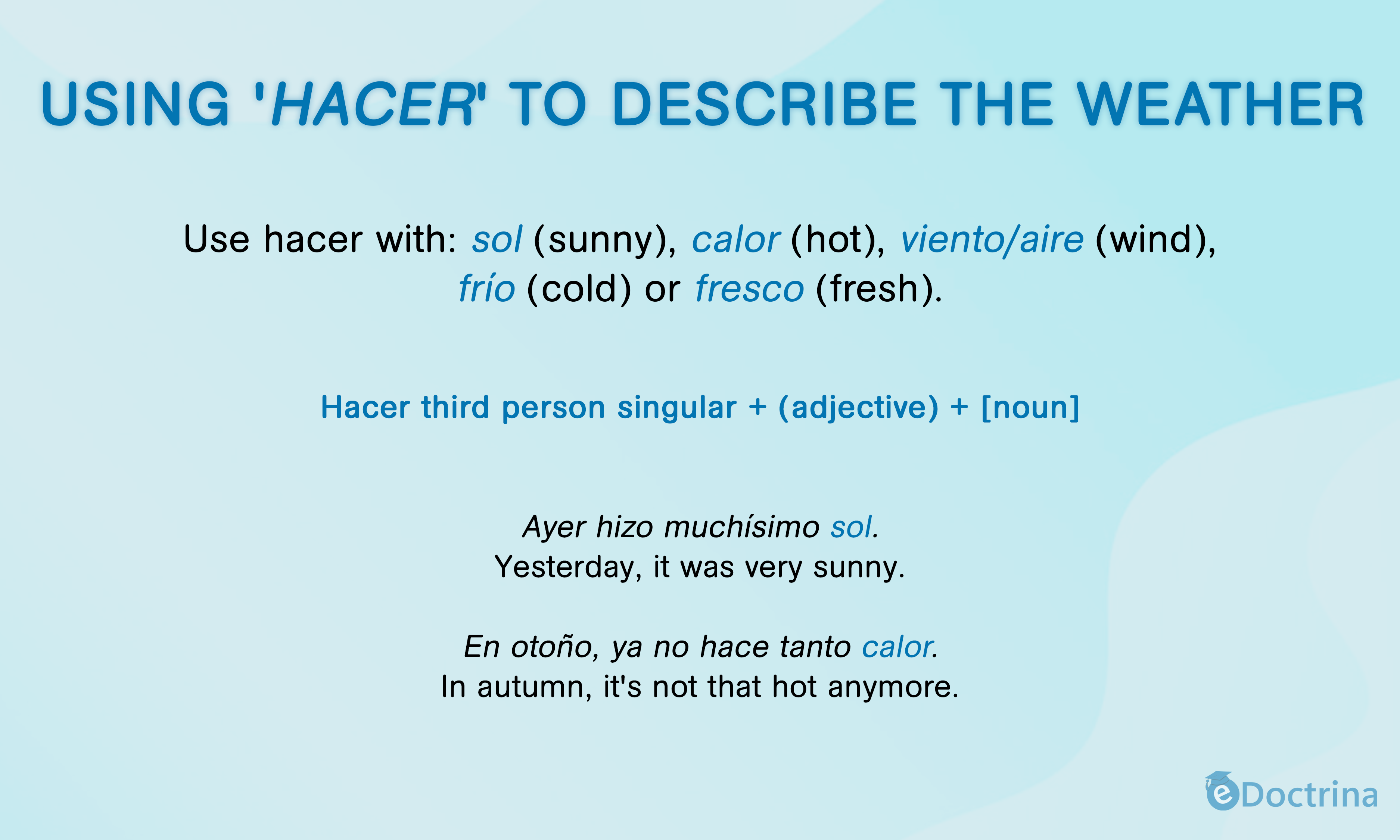
As you might be aware, “hace” stands out as one of the prevalent Spanish weather expressions.
Nevertheless, it is exclusively employed with specific nouns that enable us to articulate the prevailing weather conditions. These words encompass:
- Sol – Sunny
- Calor – Hot
- Viento / Aire – Wind
- Frío – Cold
- Fresco – Fresh
Here is the phrase structure applicable with this verb. Observe that you can incorporate adjectives to offer a more precise depiction.
Hacer third person singular + (adjective) + [noun]
En otoño, ya no hace tanto calor.
In autumn, it’s not that hot anymore.
A esta hora siempre hace sol.
It’s always sunny at this time of the day.
Cuando era niña, no hacía tanto calor.
When I was little, it wasn’t this hot.
Ayer hizo muchísimo sol.
Yesterday, it was very sunny.
Kindly observe: “Hace” is the impersonal form derived from the verb “hacer.” In essence, when discussing the weather, we consistently utilize its third-person singular conjugation. Beyond this guideline, you can conjugate this verb to suit any tense required.
Employing ‘Ser’ for Describing a Place’s Climate
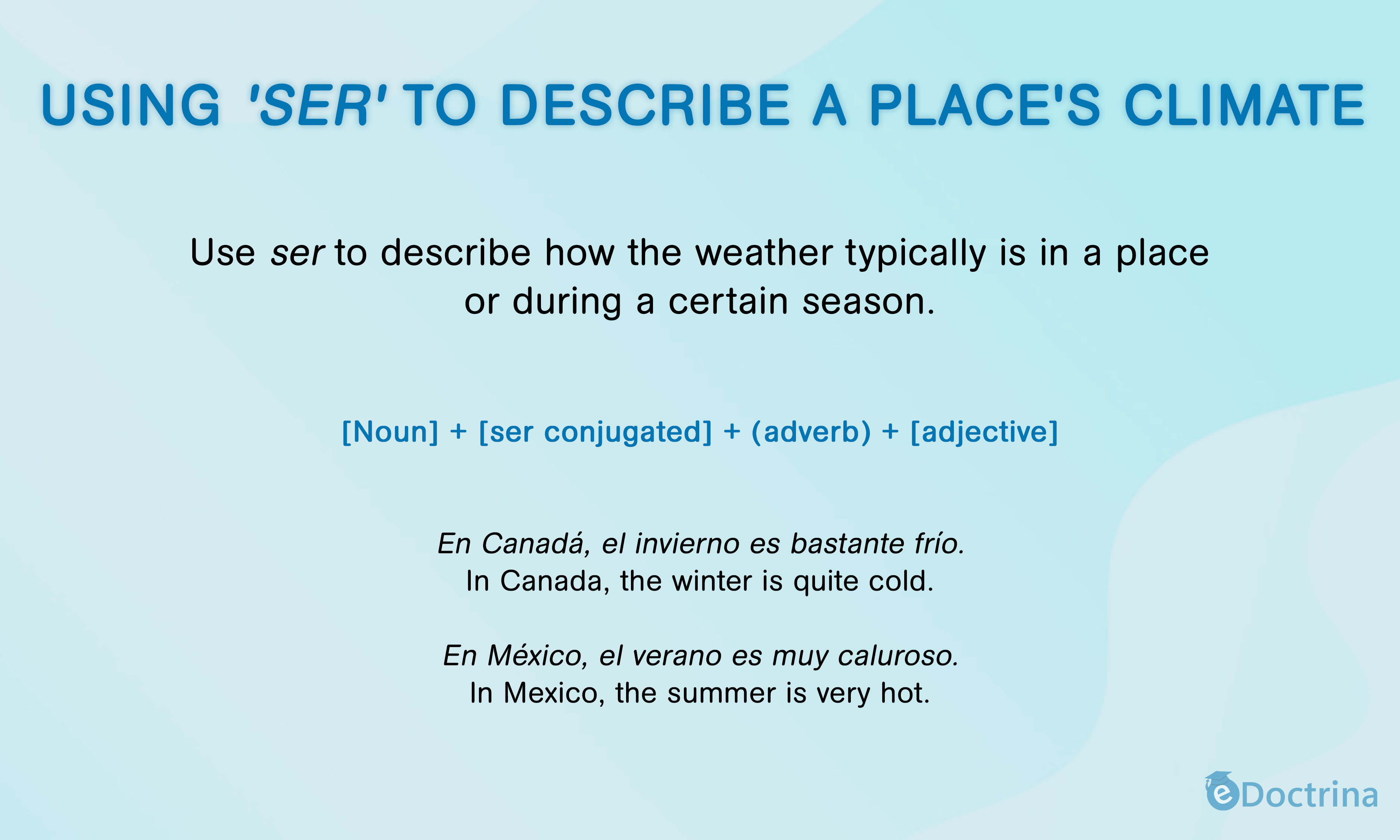
Considering that the verb “ser” is employed to delineate the characteristics of something or someone, it is also utilized to portray the typical weather conditions in a specific place or during a particular timeframe.
In straightforward terms, if I aim to provide you with a general overview of what to anticipate regarding the weather in Mexico, I would use ‘ser’.
[Noun] + [‘ser’ conjugated] + (adverb) + [adjective]
En México, el verano es muy caluroso.
In Mexico, the summer is very hot.
El clima es muy agradable en otoño.
The weather is very nice in autumn.
En Canadá, el invierno es bastante frío.
In Canada, the winter is quite cold.
Kindly observe: When discussing individuals or objects, the verb ‘ser‘ is exclusively employed to depict enduring characteristics, such as physical attributes or personality traits.
Employing ‘hay’ for Weather Discussion
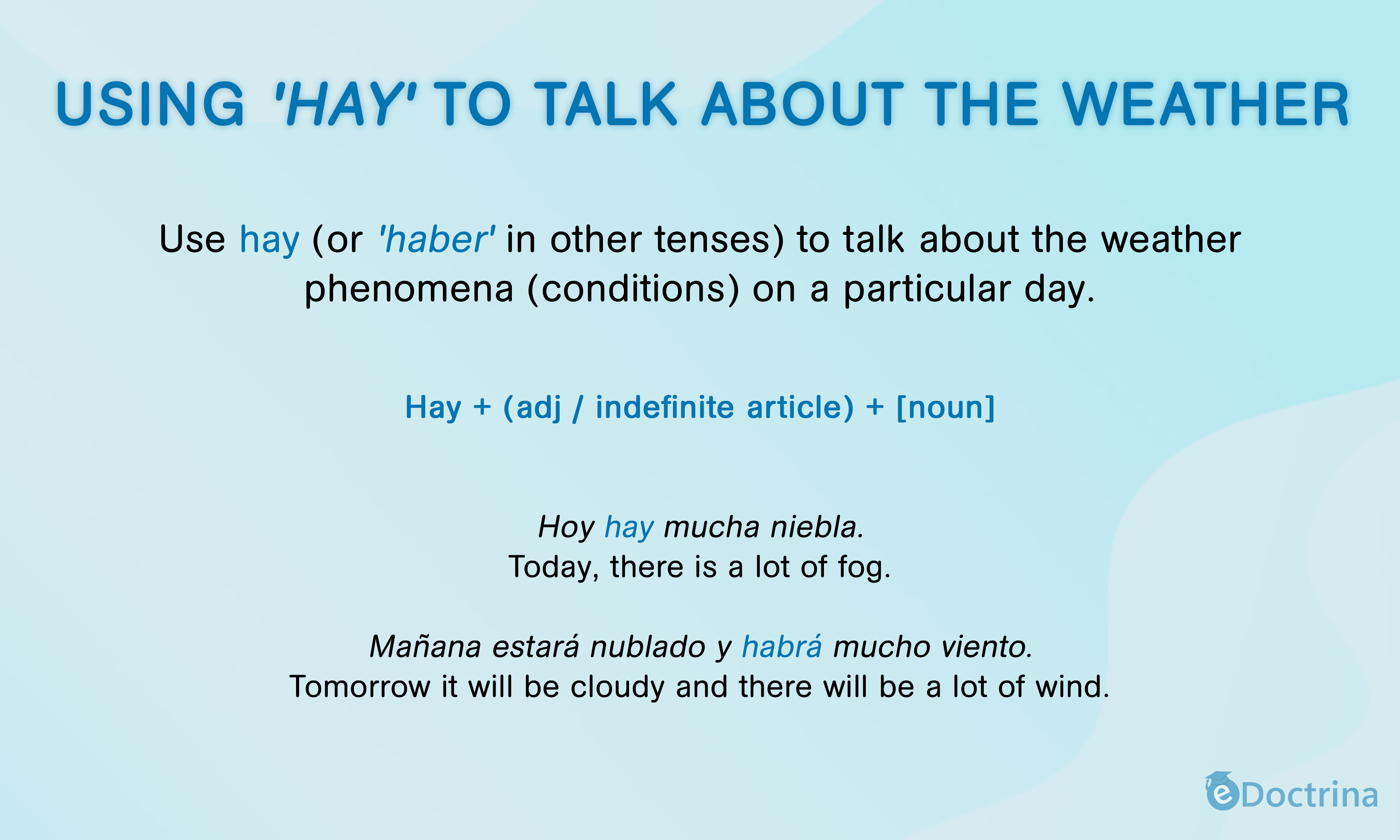
Even if it’s not on your radar, ‘hay‘ is another expression you can employ to characterize the weather in Spanish. Given its fundamental role in indicating the existence of something, we use this term to discuss weather phenomena occurring on a specific day. Typically, it is translated as ‘there is‘ or ‘there are‘.
Hay + (adj / indefinite article) + [noun]
Hoy hay mucha niebla.
Today, there is a lot of fog.
Hay una tormenta eléctrica en la costa.
There is a lightning storm on the coast.
Mañana estará nublado y habrá mucho viento.
Tomorrow it will be cloudy and there will be a lot of wind.
Applying ‘estar’ to describe current weather conditions
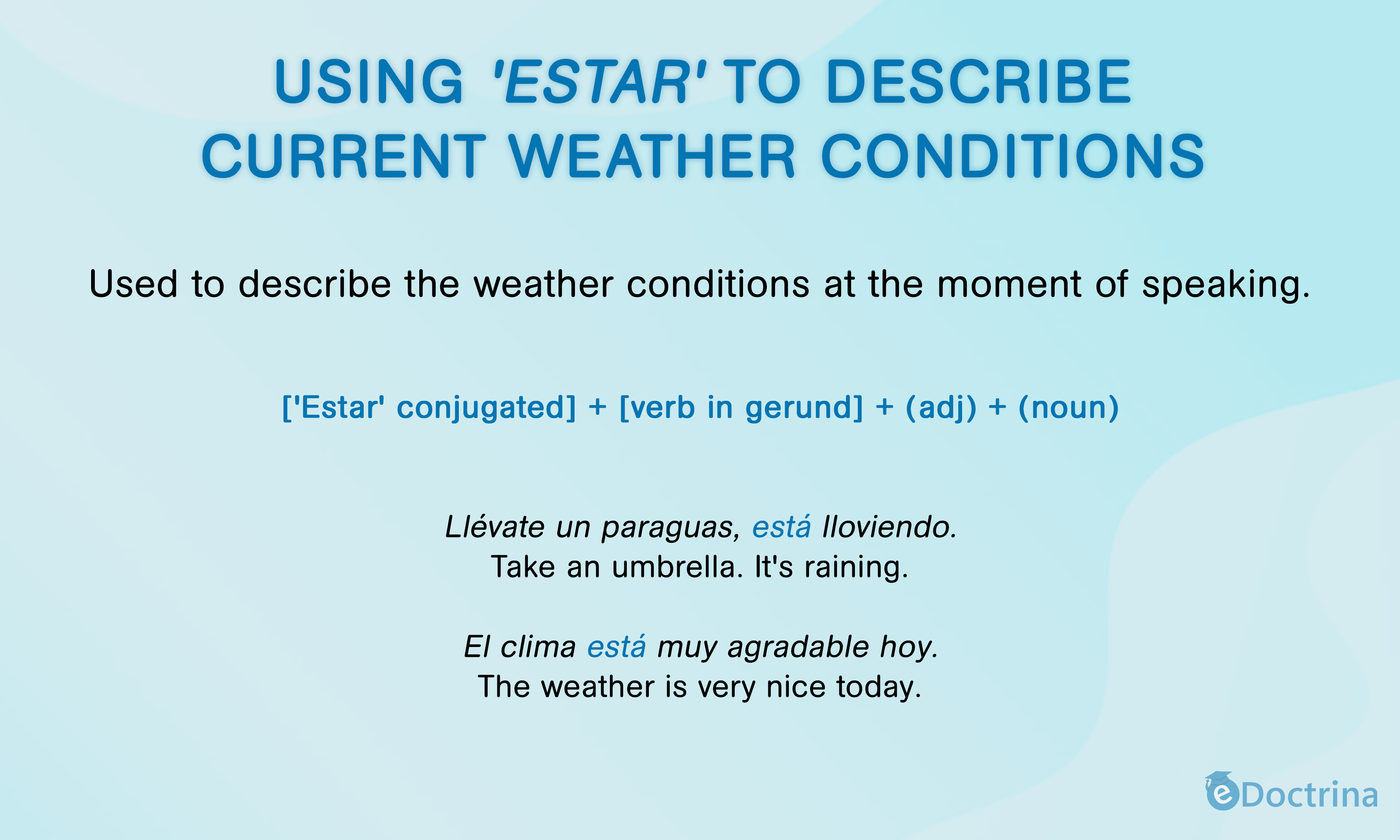
In this scenario, we turn to the verb ‘estar‘ to convey or elucidate the ongoing weather conditions at the time of conversation. To put it in simpler terms, if I want to share the current weather or discuss how it has been over the past month, ‘estar’ is my go-to. So, depending on the specific elements we want to incorporate, we have the option to select between two structures.
[‘Estar’ conjugated] + [verb in gerund] + (adj) + (noun)
Hoy está haciendo mucho calor.
Today it’s very hot.
Llévate un paraguas, está lloviendo.
Take an umbrella. It’s raining.
La semana que viene estará nevando muy fuerte.
Next week, it will be snowing very hard.
If you prefer employing an adjective instead of a verb in gerund, you can adopt the following structure:
[‘Estar’ conjugated] + (adv) + [adjective]
Ha estado muy nublado toda la semana.
It’s been really cloudy all week.
El clima está muy agradable hoy.
The weather is very nice today.
El día está fresco y con poco sol.
Today is fresh and a bit sunny.
Employ Verbs Pertaining to Weather
As you might envision, another prevalent method to depict or elucidate the weather in Spanish involves utilizing verbs associated with weather.
En verano, llueve mucho.
During summer, it rains a lot.
La semana pasada, nevó en las montañas.
Last week, it snowed in the mountains.
Llévate un paraguas porque ya se nubló.
Take an umbrella because it got cloudy.
Vocabulary: Spanish Words and Expressions for Weather
Explore this compilation of commonly used phrases and terminology to discuss and characterize the weather:
- Llover a cántaros: Raining cats and dogs
- Hacer buen tiempo: To have nice weather
- Hacer mal tiempo: To have bad weather
- Hacer un calor de los mil demonios: To be hot as hell
- Hacer un frío que pela: To be freezing cold
- Hacer frío: To be cold
- Hacer calor: To be hot
Apart from the aforementioned expressions, you can incorporate the following nouns and adjectives. I’ve included a column indicating the corresponding verb for each word.
| Spanish | English | Works with |
|---|---|---|
| Sol | Sunny | Hace |
| Soleado | Sunny | Estar |
| Frío | Cold | Hace |
| Templado | Warm | Ser / Estar |
| Calor | Hot | Hace |
| Caluroso | Hot / Warm | Ser |
| Nublado | Cloudy | Estar |
| Lluvioso | Rainy | Ser / Estar |
| Niebla | Fog | Hay |
| Relámpago | Lightning | Hay |
| Trueno | Thunder | Hay |
| Granizo | Hail | Hay |
| Nube | Cloud | Hay |
| Húmedo | Humid | Ser |
| Humedad | Humidity | Hay |
| Fresco | Fresh | Hacer / Estar |
| Tormenta | Storm | Hay |
| Seco | Dry | Ser / Estar |
| Luvia | Rain | Hay |
Discussing Past Weather in Spanish
To narrate past weather conditions in Spanish, you just have to conjugate the relevant verb into the preterite, imperfect, or any other past tense as needed. Similar to any Spanish verb, weather-describing verbs are adaptable to various tenses.
Some of my students initially found it challenging to describe the weather in tenses other than the present. However, in reality, it’s simpler than you might anticipate—ensuring the verb is conjugated to the required tense is the key.
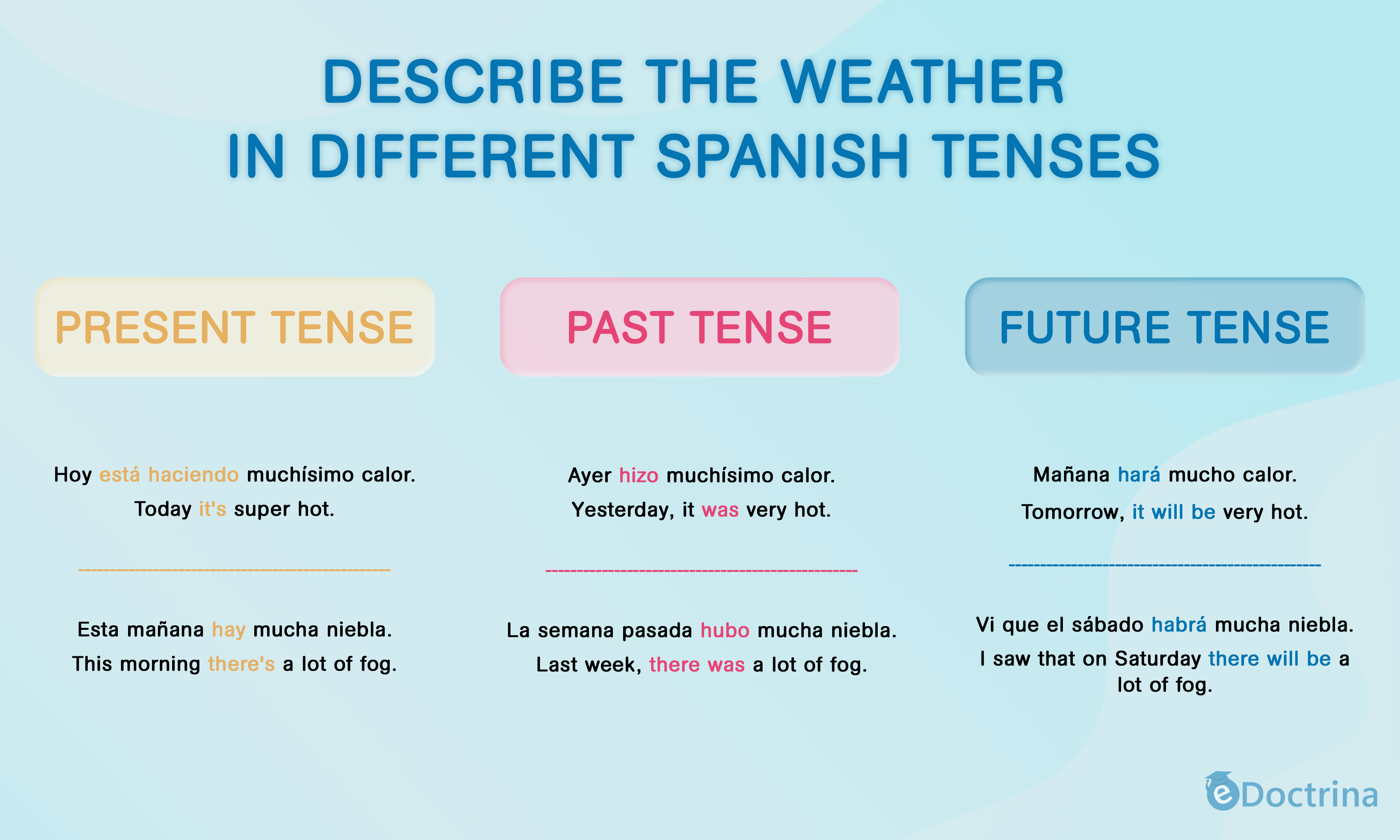
Therefore, as long as you are proficient in verb conjugation, you should encounter no difficulties. Review the examples provided below for clarification:
- Present tense
Hoy está haciendo muchísimo calor.
Today it’s super hot.
Esta mañana hay mucha niebla.
This morning there’s a lot of fog.
- Past tense
Ayer hizo muchísimo calor.
Yesterday, it was very hot.
La semana pasada hubo mucha niebla.
Last week, there was a lot of fog.
- Future tense
Mañana hará mucho calor.
Tomorrow, it will be very hot.
Vi que el sábado habrá mucha niebla.
I saw that on Saturday there will be a lot of fog.
Kindly observe: In the realm of discussing weather predictions, we employ either the verb ‘esperar‘ (to expect) or ‘pronosticar‘ (to forecast).
Essential Highlights
Mastering the ability to discuss the weather in Spanish not only serves as a potential icebreaker (especially for individuals like me) but also offers a valuable chance to hone common (and occasionally perplexing) verbs and grammatical structures.
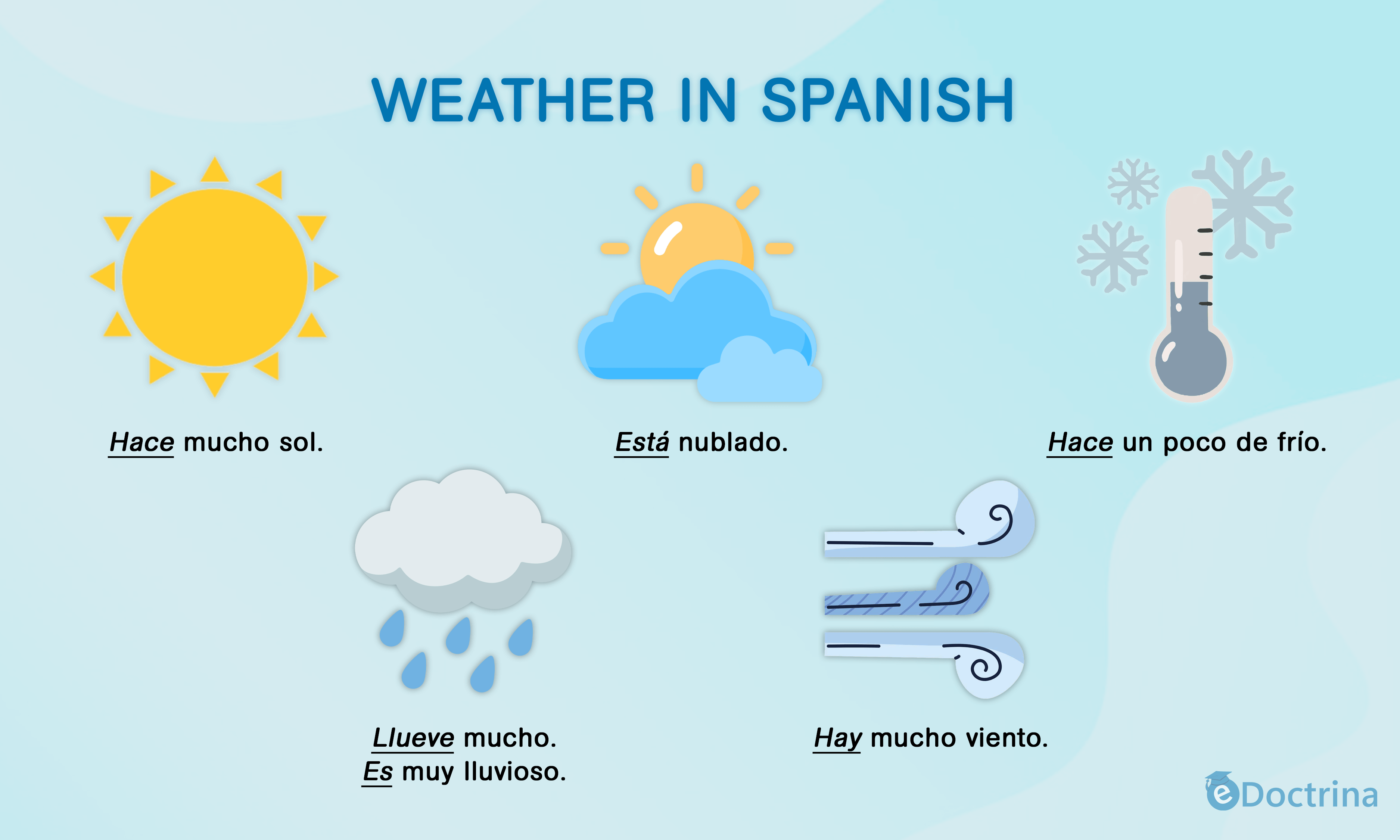
As we cover various aspects, here are some key takeaways to bear in mind:
- ‘Ser‘ is used to depict or inquire about typical weather patterns during a season or in a specific location.
- ‘Hace‘ is employed with certain nouns to discuss or inquire about weather conditions and temperatures.
- ‘Estar‘ is used to portray or inquire about the current weather conditions.
- Both ‘ser‘ and ‘estar‘ are compatible with adjectives.
- All these verbs can be conjugated to any tense to depict the weather at a particular moment.
With these insights, you should now be well-acquainted with discussing weather in Spanish. Armed with this knowledge, you have a conversation starter at your disposal if needed.
